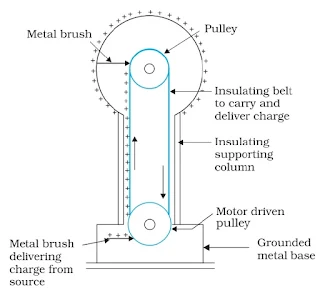Van de Graaff Generator | Working Method and Construction
Van de Graaff Generator
Van de Graaff generator was designed by Robert J. Van de Graaff in 1929. This is a machine which can be build up high voltages of the order of a few million volts. The resulting large electric fields are used to accelerate charged particles like protons, deutrons, alpha particles and ions to high energies needed for experiments to probe the small-scale structure of matter.
 |
| Van de Graaff Generator |
Construction
As shown in Fig, we take a large-sized spherical conducting shell supported at a height of several meters above the ground on an insulating supporting column. A long, narrow and endless belt of insulating material like rubber or nylon is wound around two pulleys, pulley P1 at ground level and Pulley P2 at the center of the spherical shell. The belt is kept continuously moving by a motor driving the lower pulley P1. C1 and C2 are two metal combs having a large number of thin wire strands. The lower comb, called the spraying comb is joined to positive terminal of a High Tension power supply (HT power supply) providing a voltage of about 10 kV. Negative terminal of HT supply is earthed by joining it to a grounded metal base. The upper comb C2 is connected to the inner surface of a conducting shell.
Working Method
When the high tension power supply is switched on, the sharpness of spray comb C1 develops a high electric field leading to ionization of neighbouring air molecules. Negative ions move towards the sharp edges of comb C1 and positively charged ions towards the belt. This positive charge sticks to the belt. The negative charge naturalizes some of the positive charge on C1. The power supply maintains the positive potentials of the comb by supplying more charge to it. In this way, effectively, positive charge is transferred from HT supply to the belt.
As the belt moves, the positive charge moves upward along with belt. When it reaches near the upper comb C2 the sharp pointed wire ends of it draw off the charge from the belt and immediately transfer it to conducting spherical shell. The positive charge received by the shell uniformly spreads on its under surface.
The process of charge transfer from HT supply to belt through comb C1 and from belt to spherical shell through comb C2 continuous. As a result, the charge and consequently, the positive potential of a spherical shell goes on increasing and may rise to an exceedingly high value of few million volts. As potential becomes exceedingly high, the electric field outside the charged spherical shell may approach the dielectric breakdown limit of air and no more charge can be transferred to spherical shell. Thus, effectively, voltage difference of few million volts (= 6 to 8 MV) between spherical shell and ground may be built up.
Uses
- It is used in generating high potential difference.
- It is used in studying of nuclear physics.

